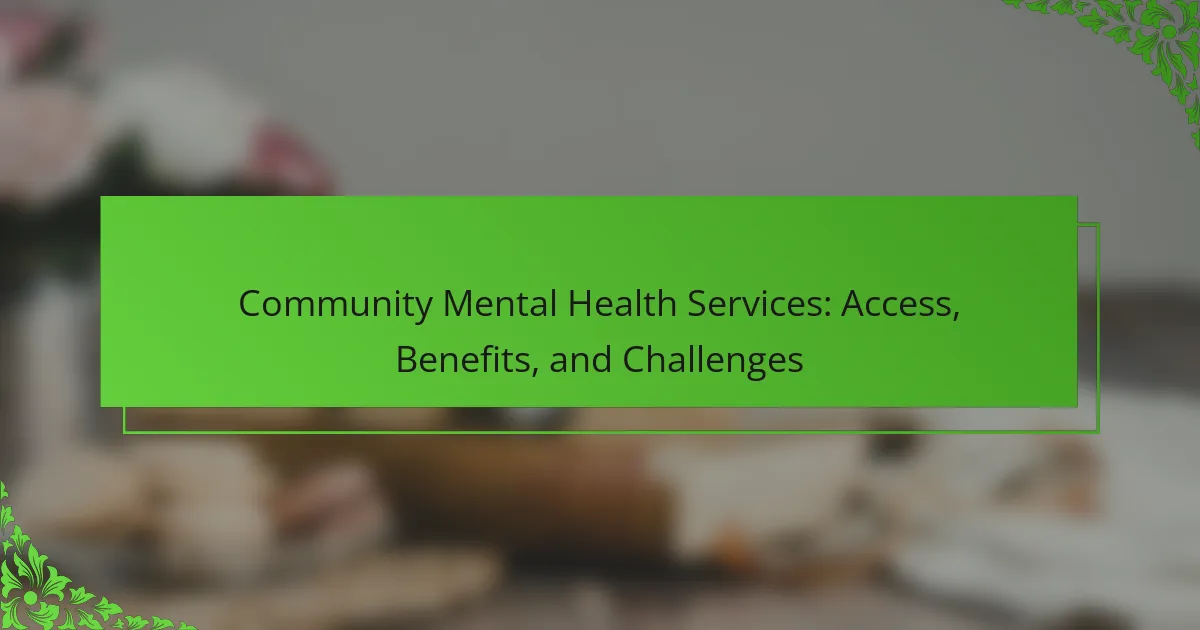Access to community mental health services is crucial for improving individual well-being and promoting social inclusion. However, stigma, lack of awareness, and inadequate funding create significant barriers to accessing these essential resources. This article explores the benefits of community mental health services, the challenges they face, and innovative approaches to enhance their effectiveness. Understanding these aspects is vital for fostering a supportive environment for mental health care.
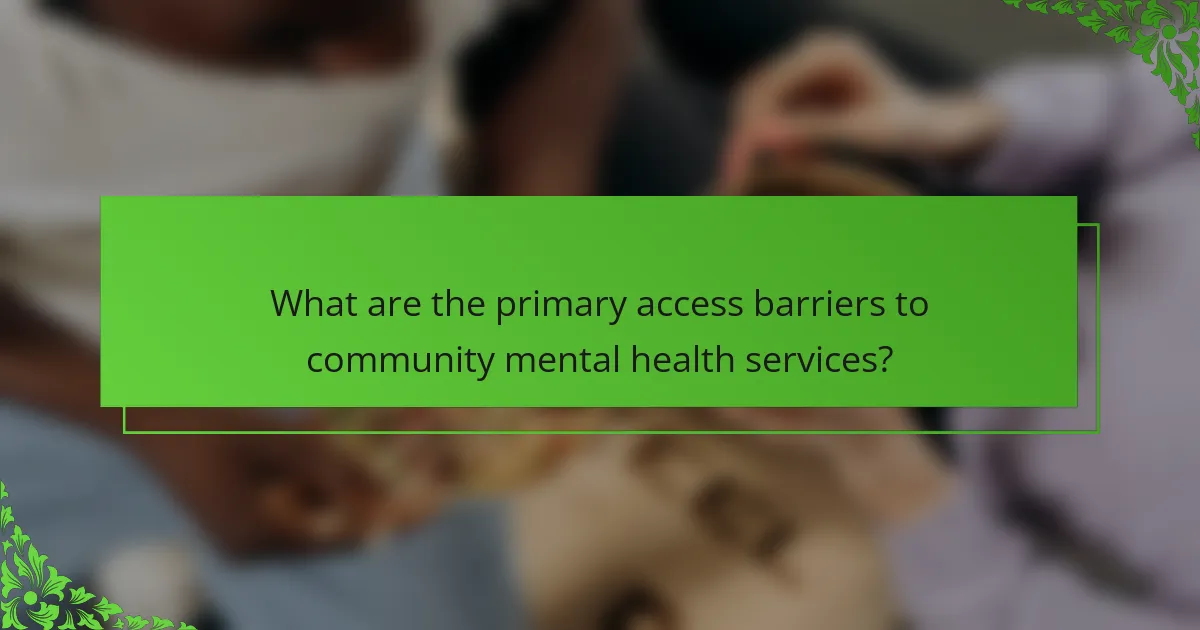
What are the primary access barriers to community mental health services?
Primary access barriers to community mental health services include stigma, lack of awareness, inadequate funding, and transportation challenges. Stigma surrounding mental health often prevents individuals from seeking help. Many people are unaware of available services or how to access them. Inadequate funding limits resources and service availability. Transportation issues can hinder access, especially in rural areas.
How do socioeconomic factors influence access?
Socioeconomic factors significantly influence access to community mental health services. Individuals from lower socioeconomic backgrounds often face barriers such as limited financial resources, lack of transportation, and reduced awareness of available services.
For example, studies show that communities with higher poverty rates experience fewer mental health service providers, leading to increased unmet needs. Additionally, educational disparities can affect understanding and utilization of mental health resources.
Access is further complicated by stigma associated with mental health issues, particularly in economically disadvantaged areas. As a result, socioeconomic status plays a crucial role in determining who receives care and the quality of that care.
What role does stigma play in seeking help?
Stigma significantly hinders individuals from seeking help for mental health issues. Many fear judgment, leading to reluctance in accessing community mental health services. This avoidance perpetuates a cycle of untreated conditions, impacting overall community well-being. Research shows that reducing stigma can increase service utilization and improve mental health outcomes.
Which populations are most affected by access issues?
Low-income individuals, racial minorities, and rural populations face significant access issues to community mental health services. These groups often experience barriers such as financial constraints, stigma, and limited availability of local services. For instance, studies show that rural areas have fewer mental health professionals per capita, impacting service accessibility. Additionally, cultural differences may hinder effective communication and trust between providers and minority populations, further complicating access. Addressing these disparities is crucial for improving mental health outcomes across affected communities.
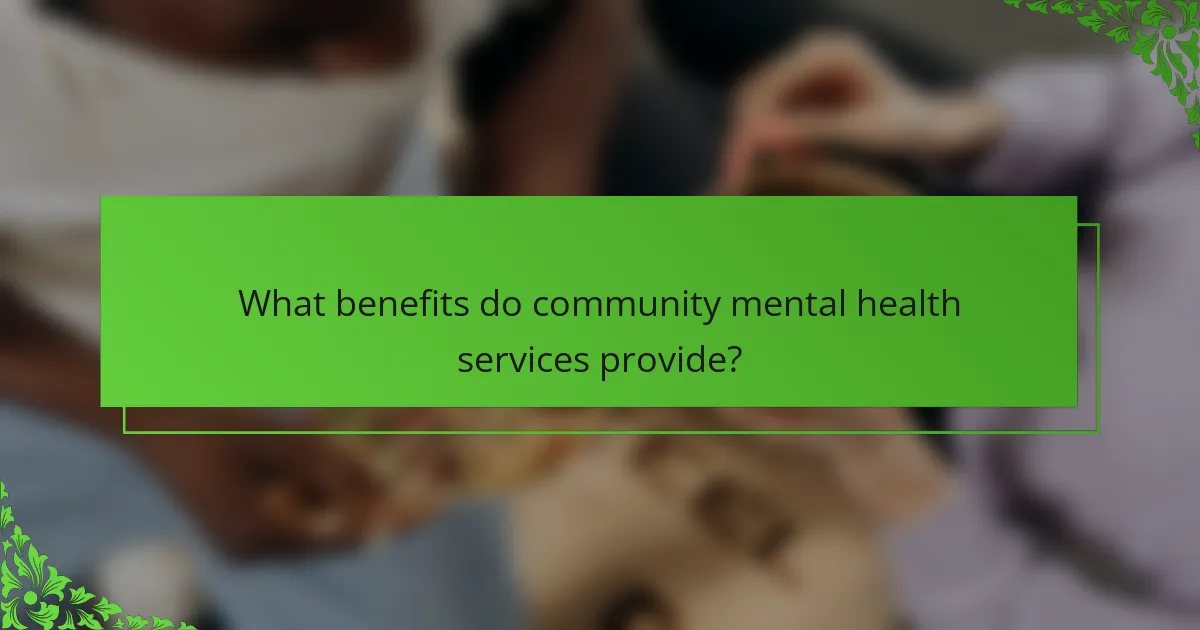
What benefits do community mental health services provide?
Community mental health services provide essential support, improving access to care, enhancing quality of life, and promoting social inclusion. These services reduce stigma and facilitate early intervention, leading to better outcomes for individuals. They also offer a range of therapeutic options, including counseling and crisis intervention, tailored to community needs. As a result, communities experience a decrease in hospitalization rates and improved overall mental health.
How do these services improve overall well-being?
Community mental health services enhance overall well-being by providing accessible support, fostering social connections, and improving mental health outcomes. These services offer resources that reduce stigma, promote recovery, and empower individuals. Access to community-based care increases engagement and participation in treatment, leading to better coping strategies and resilience. As a result, individuals experience improved quality of life and reduced symptoms of mental health disorders.
What role do community mental health services play in crisis intervention?
Community mental health services play a crucial role in crisis intervention by providing immediate support and resources. They offer trained professionals who can assess mental health needs, stabilize individuals in crisis, and connect them to ongoing care. These services enhance community resilience by promoting early intervention and reducing the burden on emergency services. Access to these resources can significantly decrease the duration and severity of mental health crises, ultimately leading to better outcomes for individuals and communities.
How do preventive measures contribute to long-term mental health?
Preventive measures significantly enhance long-term mental health by reducing the risk of developing mental disorders. Community mental health services play a crucial role in this process by providing accessible resources and support systems. These services offer early intervention programs, which can identify and address mental health issues before they escalate.
Additionally, community initiatives promote social connections, fostering a sense of belonging that is vital for mental well-being. Research indicates that individuals engaged in community support activities report lower levels of stress and anxiety. However, challenges such as funding limitations and accessibility issues can hinder the effectiveness of these services. Addressing these challenges is essential to maximize the benefits of preventive measures in promoting long-term mental health.
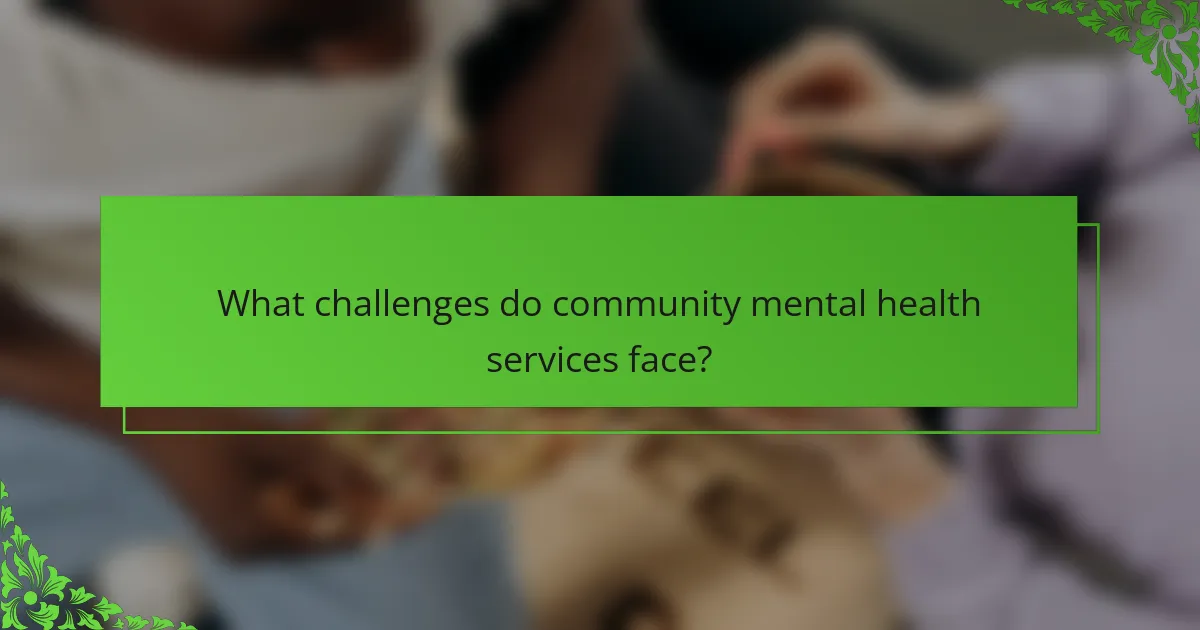
What challenges do community mental health services face?
Community mental health services face several significant challenges that impact their effectiveness. Limited funding restricts access to necessary resources and personnel. Stigma surrounding mental health continues to discourage individuals from seeking help. Additionally, workforce shortages lead to inadequate service provision, affecting the quality of care. Geographic disparities also create barriers, leaving rural areas underserved. Finally, inconsistent policy frameworks hinder the integration of services, complicating treatment pathways for patients.
How does funding impact service availability?
Funding significantly impacts service availability in community mental health services by determining resource allocation and program sustainability. Increased funding enhances access to diverse mental health programs, allowing for more comprehensive treatment options. Conversely, inadequate funding leads to service limitations, longer wait times, and reduced program hours. For instance, a study found that communities with higher funding levels reported a 30% increase in service availability compared to those with budget cuts. Ultimately, stable funding is crucial for ensuring equitable access to mental health services, addressing both immediate needs and long-term community health outcomes.
What systemic issues hinder effective service delivery?
Systemic issues such as funding shortages, workforce shortages, and bureaucratic barriers hinder effective community mental health service delivery. These challenges limit access and reduce the quality of care provided to individuals in need.
Funding shortages often result in insufficient resources for programs, impacting service availability. Workforce shortages lead to high caseloads for mental health professionals, which can diminish the quality of care. Bureaucratic barriers create delays in service access, complicating the process for individuals seeking help.
Additionally, stigma surrounding mental health can discourage individuals from utilizing available services. A lack of awareness about available resources further exacerbates these issues, leaving many without necessary support.
Addressing these systemic challenges is crucial for enhancing the effectiveness of community mental health services and improving overall outcomes for individuals in need.
Which challenges are unique to specific regions?
Access to community mental health services faces unique challenges in different regions. Rural areas often lack resources and trained professionals, limiting service availability. Urban regions may experience overcrowding and funding disparities, affecting service quality. Cultural stigma can hinder utilization in specific communities, while socioeconomic factors impact accessibility across various regions. Additionally, geographic isolation in remote areas presents logistical barriers for individuals seeking help.
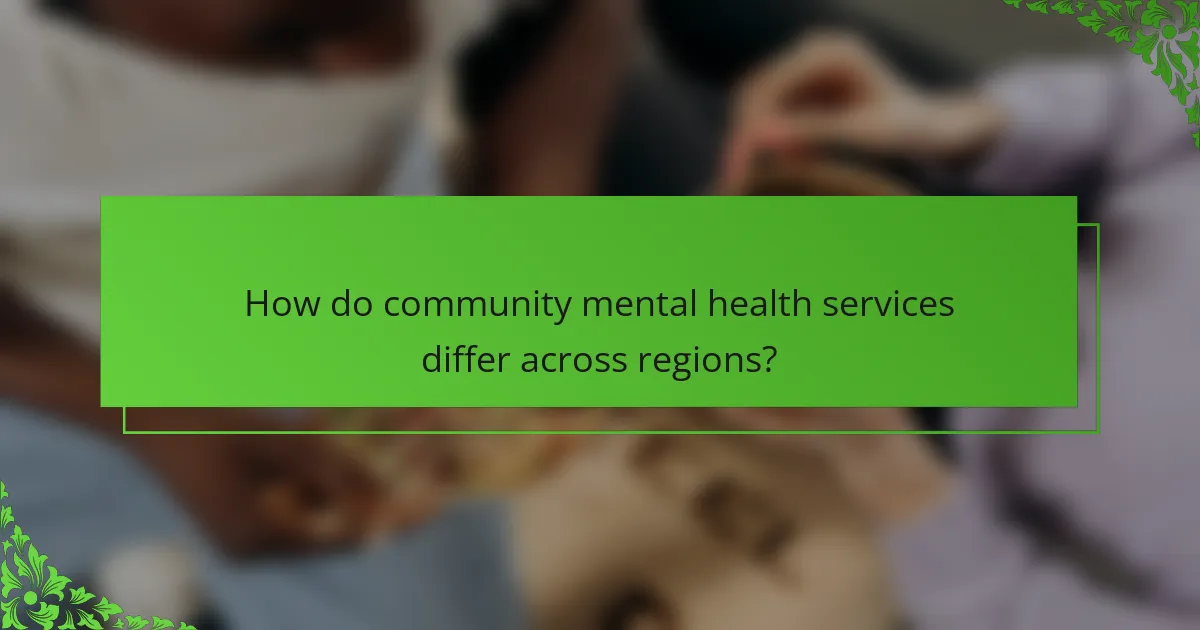
How do community mental health services differ across regions?
Community mental health services vary significantly across regions due to factors like funding, cultural attitudes, and available resources. Access to services often reflects local government priorities, which can lead to disparities in treatment availability. In urban areas, services may be more comprehensive, while rural regions often face challenges like limited providers and transportation issues. Additionally, cultural perceptions of mental health can influence how services are utilized and accepted within communities. For instance, some regions may prioritize preventive care, while others focus on crisis intervention.
What are the varying service models in different countries?
Community mental health services vary significantly across countries, impacting access, benefits, and challenges. In countries like the United States, services often focus on individualized care with a wide range of treatment options. In contrast, many European nations prioritize integrated care models that emphasize community-based support. Access can be hindered by factors such as funding disparities and cultural stigma, which affect service utilization. Additionally, challenges include workforce shortages and varying levels of governmental support, complicating the delivery of effective mental health care globally.
How do cultural perceptions influence service utilization?
Cultural perceptions significantly impact the utilization of community mental health services. Stigma, beliefs about mental health, and cultural values shape individuals’ willingness to seek help. For instance, in some cultures, mental health issues may be viewed as personal weaknesses, discouraging individuals from accessing services. Additionally, language barriers and lack of culturally competent care can hinder service utilization. Understanding these cultural dynamics is essential for improving access and tailoring services to meet community needs.
What regional initiatives have shown success in improving access?
Regional initiatives that have improved access to community mental health services include integrated care models and telehealth programs. Integrated care models combine mental health and primary care, facilitating holistic treatment. Telehealth programs expand reach, especially in rural areas, providing remote consultations.
For example, the Collaborative Care Model in the United States has shown success by embedding mental health professionals in primary care settings, increasing patient access by 50%. Similarly, the Ontario Telemedicine Network in Canada has enhanced service delivery with over 1 million virtual visits annually, improving accessibility for underserved populations.
These initiatives address barriers such as stigma and transportation, ensuring that mental health services are more readily available to those in need.
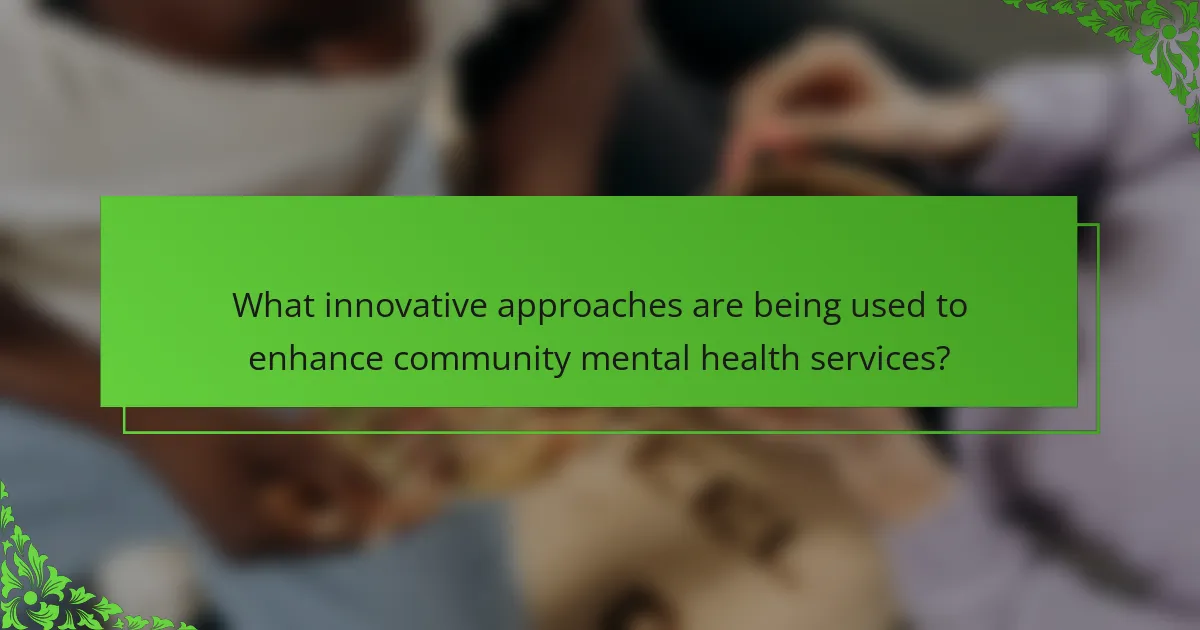
What innovative approaches are being used to enhance community mental health services?
Innovative approaches to enhance community mental health services include integrated care models, digital health technologies, and peer support initiatives. Integrated care combines mental health and primary care, improving access and coordination. Digital health technologies, such as teletherapy and mental health apps, increase accessibility and engagement. Peer support initiatives leverage lived experiences to foster community connection and resilience. These strategies address the root challenges of stigma and access while promoting holistic well-being.
How is technology transforming service delivery?
Technology is revolutionizing community mental health services by enhancing access, improving efficiency, and personalizing care. Telehealth platforms enable remote therapy sessions, making mental health support more accessible. Data analytics help identify patient needs, leading to tailored interventions. However, challenges include digital divide issues and privacy concerns. Addressing these obstacles is crucial for maximizing technology’s benefits in mental health care.
What role do community partnerships play in service enhancement?
Community partnerships significantly enhance mental health services by improving access and resource sharing. They foster collaboration among organizations, leading to more comprehensive care. Partnerships can address specific community needs, ensuring services are culturally relevant and accessible. For example, joint initiatives can provide outreach programs, reducing stigma and increasing awareness. These collaborations often lead to innovative solutions that tackle the unique challenges faced by different populations, ultimately improving overall mental health outcomes.
Which unique programs have emerged in recent years?
Several unique programs have emerged in recent years to enhance community mental health services. These initiatives focus on accessibility, integration, and tailored support for diverse populations.
One notable program is the Mental Health First Aid initiative, which trains community members to provide initial support to individuals in crisis. This program has expanded access by empowering non-professionals to recognize and respond to mental health issues.
Another innovative approach is the integration of telehealth services, which has significantly increased access to mental health care, especially in rural areas. Telehealth allows for flexible scheduling and reduces barriers related to transportation and stigma.
Peer support programs have also gained traction, offering individuals with lived experiences the opportunity to assist others facing similar challenges. These programs foster a sense of community and belonging, enhancing overall mental wellness.
Lastly, crisis intervention teams have been developed in various communities to provide immediate support during mental health emergencies. These teams, often composed of trained police officers and mental health professionals, work to de-escalate situations and connect individuals to appropriate resources.
How can advocacy improve community mental health services?
Advocacy can significantly enhance community mental health services by increasing funding, promoting awareness, and influencing policy changes. These efforts lead to improved access to care and better quality of services. Advocacy groups can mobilize community support, ensuring mental health issues receive the attention they deserve. As a result, individuals benefit from more comprehensive and responsive mental health resources.
What practical strategies can individuals utilize to navigate community mental health services?
Individuals can navigate community mental health services by utilizing several practical strategies. First, research available services in the local area to understand options. Second, connect with local mental health organizations for guidance and support. Third, engage with a primary care physician who can provide referrals and recommendations. Fourth, utilize online resources and hotlines for immediate assistance. Lastly, attend community events to network with mental health professionals and peers. These strategies enhance access to services, maximizing benefits while addressing potential challenges.
